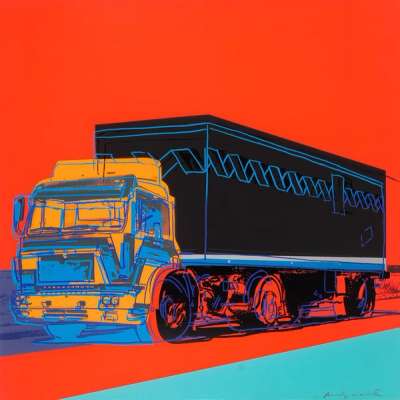Truck
Andy Warhol’s Truck (1985) series draws parallels between an icon of modern American industry and the lone journeying cowboy. The product of a German commission, for International Road Transportation Union, Warhol executed, as ever, a witty challenge to ‘high’ art by rendering the everyday vehicle in Pop-art style.
Andy Warhol Truck For sale
Truck Value (5 Years)
Works from the Truck series by Andy Warhol have a strong market value presence, with 26 auction appearances. Top performing works have achieved standout auction results, with peak hammer prices of £151200. Over the past 12 months, average values across the series have ranged from £30502 to £113247. The series shows an average annual growth rate of 5.71%.
Truck Market value
Auction Results
| Artwork | Auction Date | Auction House | Return to Seller | Hammer Price | Buyer Paid |
|---|---|---|---|---|---|
 Truck (complete set) Andy Warhol Signed Print | 16 Apr 2025 | Christie's New York | £93,500 | £110,000 | £140,000 |
 Truck (F. & S. II.369) Andy Warhol Signed Print | 1 Nov 2023 | Doyle Auctioneers & Appraisers | £22,950 | £27,000 | £35,000 |
 Truck (F. & S. II.367) Andy Warhol Signed Print | 26 Oct 2023 | Phillips New York | £24,650 | £29,000 | £40,000 |
 Truck (F. & S. II.370) Andy Warhol Signed Print | 13 Jun 2019 | Bonhams New Bond Street | £12,750 | £15,000 | £19,000 |
Sell Your Art
with Us
with Us
Join Our Network of Collectors. Buy, Sell and Track Demand
Meaning & Analysis
Warhol’s Truck series presents the archetypal truck - an icon of modern industry - overlaid in contrasting colours to render it a work of Pop Art. Published in 1985 in conjunction with the Federal Association of German Long-Distance Goods Transport to commemorate the 20th World Congress of International Road Transportation Union, the portfolio consists of four prints. The series is printed on Lenox Museum Board, with each print signed in pencil and numbered in an edition of 60 with 15 artist's proofs.
Each print reproduces a photograph of a truck in flat, pop colours, with the addition of hand drawn lines to pick out detail and lend movement to the subject, a technique seen in the Love series of 1983 and The Birth of Venus from 1984. However, while in those series Love and Desire were represented by the female body, here we see the desire for consumerism become the subject of the print, which is perhaps what Warhol found appealing about the commission. With long distance journeys across mountain ranges, deserts and forests, the long distance truck driver became somewhat of a romantic figure in 20th century America, the lonesome drives becoming associated with the arduous journeys of cowboys on horseback during the conquest of the West.
Here Warhol has taken the symbol of the truck and raised it to the level of both kitsch and ‘high art’, as he did with many household objects – such as his Campbell's Soup Cans and Brillo Boxes – in his practice of taking the everyday and asking you to look again at objects that usually go unnoticed. This effect is achieved by way of the silk screen, a technique Warhol had mastered in the ’60s and which by the ’80s had become his calling card, with prints made in large editions at the Factory, with help from assistants, as well as at external printers such as Rupert Jasen Smith, who printed this particular portfolio.
With Truck the medium, as with many of this works, fits the message; screen printing was traditionally the process of choice for commercial printers and here Warhol demonstrates his canny ability to reclaim it for his own celebration of the world of commerce. He enjoyed the irregularity of the method, describing it as “quick and chancy … you get the same image, slightly different each time” as well as the accessibility of creating multiples rather than unique artworks which are only owned and appreciated by a small art world elite. Instead, with works such as Truck, he was able to bring his work to a wide audience, appealing to the collective nostalgia for being ‘on the road’.
















